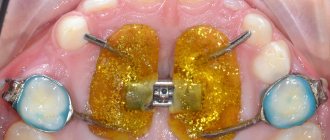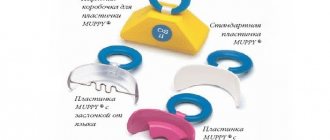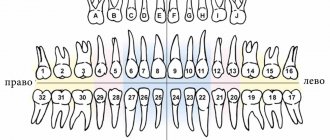Among the products used during orthodontic correction, orthodontic ring crowns are often found. Despite their less popularity, such designs were invented much earlier than braces. The first devices for correcting malocclusions and dentition were precisely crowns, to the surface of which guide tubes and hooks were attached, which in turn were fastened with rubber rods, which created the pressure necessary to move the teeth. However, the results achieved as a result of the use of such systems were difficult to predict, which led to their imperfection.
The use of crowns was determined by the lack in those days of composite materials that would guarantee a strong connection with the surface of the tooth enamel. Obviously, the “cover” placed over the tooth caused inconvenience to the patient, interfering with the full occlusal closure of the rows. This is what influenced the decision to cut off the upper part of the structure, and led to the appearance of orthodontic rings. For their fixation, not the most reliable types of dental cement were still used, but the absence of obvious interference that made it difficult to perform chewing movements and dock with antagonists was in itself a significant progress.
Over time, products in the form of rings equipped with fastening hooks gave way to traditional braces, in which the power arc is placed in a torque, which allows for precise correction of the position of problem units. Advances in technology have increased the effectiveness of treatment, but rings were still required to secure the brackets to the enamel surface.
Resorption of tooth roots
First of all, it is necessary to talk about the resorption of tooth roots, if we say in general terms - about the resorption of roots. This process has not yet been fully studied and threatens the patient’s complete loss of teeth. Prolonged mechanical impact from the braces system often leads to resorption of the tooth bone tissue. It is very important, at the beginning, middle and at the end of the bite correction, to take diagnostic photographs and look at the condition of the roots, since resorption at the initial stage is completely asymptomatic. Treatment of root resorption is complex, multi-step and expensive. Quite often I hear from patients that a doctor installs a brace system without analyzing an OPTG or CBCT image, without impressions or any diagnostics. This is a gross, dangerous mistake, since the bracket system is not indicated in all cases, and setting it “at random” can lead to unpleasant and often irreversible consequences. Be careful when choosing a specialist.
Why do patients trust Aza&Buka dentistry?
When carrying out orthodontic treatment, Aza&Buka Pediatric Dentistry focuses on the most modern protocols and selects correction methods that are optimal for the child. For patients and their parents this means:
- Professionalism of doctors. Pediatric orthodontists will conduct a full diagnosis, explain whether a plate is placed on baby teeth if only one unit is missing, and choose the optimal treatment regimen to preserve the bite.
- Making the device from casts. To ensure that the space retainer accurately matches the child's bite, the doctor will take impressions, create a plaster model, and order a dental laboratory to make a replacement plate exactly for the child's baby teeth.
- The ability to find an approach to each child. Removable orthodontic plates are prescribed to be worn almost constantly. Children often sabotage this moment. After communicating with Aza&Buka orthodontists, the children themselves ensure that the plate is in their mouth - they do not become capricious and do not argue with their parents.
How to install
Installation of an orthodontic ring takes place in three stages and includes:
- sanitation of the oral cavity;
- mechanical spreading of teeth in order to create free space where the bandage will stand;
- fixation of the ring with orthodontic cement.
Preparation
Sanitation of the oral cavity includes treatment of teeth and/or gums, and, if necessary, hygienic cleaning. Particular attention is paid to chewing teeth - molars, on which it is planned to install a ring.
Next, an examination is scheduled, and the patient takes panoramic photographs of the jaws and undergoes blood and urine tests.
Spacer installation
Before placing the metal bandage, you need to make room for it. This is done using spacers installed on both sides of the abutment tooth. If there are spacers, teeth next to or under them will not be able to be cleaned, which should be warned by the orthodontist.
It is advisable that the spacer remain in your mouth until your next visit to the doctor. However, it happens that it falls out spontaneously, thereby indicating the result achieved: the necessary space has been created. In this case, you should call or visit a doctor, who will either install a new spacer or set a date for installing the ring itself.
Spacers come in rubber and metal, but rubber is most often used. The principle of their operation is extremely simple: when inserted into the interdental spaces, the rubber compresses and becomes very thin, but within a few days it returns to its original thickness. Thanks to this, the teeth gradually move apart, providing access to the unit being banded.
An orthodontic ring is not placed on a tooth with a spacer, so the spacers are removed in advance.
Take note!
It takes one to two weeks to create gaps using rubber spacers.
If the contact is too tight, metal spacers are placed between adjacent teeth, since there is simply no room there for a rubber ligature.
Before installing an orthodontic ring for children, spacers are not always needed, since the distance between the teeth in a child can change due to the active growth of the jaws and the appearance of permanent molars.
Fixation
First, the ring for the teeth is selected according to their size. When choosing, the doctor focuses on the product labeling and tries it on. Having decided on the size, it is fixed to the dental unit and adjusted to shape. This adjustment stage is very important, since the duration and quality of the correction depends on it.
The ring is “set” on special cement, which hardens in 5-10 minutes. To improve adhesion, the inner surface of the product has notches. A bracket plate with two notches and a hook is soldered to the outside of the ring.
Advantages of the technique
A properly selected crown, fixed with dental cement, reliably blocks access to the base from the outside. This means that tooth enamel is protected from pathogenic bacteria and microbes that provoke the development of caries and other diseases. In addition, dentists note a number of positive aspects, including:
- Reducing the duration of correction due to the absence of the likelihood of individual braces coming off;
- Easy to maintain oral hygiene;
- Ability to use extraoral appliances, including a facebow.
After completion of orthodontic treatment, the orthodontic ring is removed, and the patient is given a date to visit an orthopedic dentist to make an artificial crown for the already treated tooth.
Basharova's bite former
The former is designed for timely correction of malocclusions.
Operating principle
Basharova’s device is a mechanical type device. Its design involves the presence of special springs and screws that apply pressure in the right places.
Indications for installation
The use of a corrector is due to the need to correct sagittal malocclusions.
Manufacturing process and installation
Before creating the device, the doctor takes all necessary measurements. In a special laboratory, based on the obtained measurement results, the jaw is reproduced on a model.
Then comes the stage of preparing a wax prototype of the device. Only after making sure that all elements are accurate and correct do they replace the wax with real material.
Treatment process
The duration of treatment can range from 1-2.5 years. This is influenced by the severity of the pathology. It is necessary to carefully monitor the design to speed up the process.
Advantages and disadvantages
Basharova’s device is distinguished by its relatively low cost, the absence of the need for constant monitoring by a doctor, and the achievement of one hundred percent results.
Among the disadvantages, it is worth noting the presence of pain that occurs during the adaptation period, the relative visibility of the device, and the difficulty of care.
Price
The average cost is 7-10 thousand rubles.
Design features
The advisability of using seemingly outdated rings or crowns is determined by the significant loads placed on the molars. Practice shows that a well-chosen and well-fixed ring can withstand greater pressure than a composite. However, in order to install rings on the chewing elements, you will need to visit your dentist at least twice.
During the first session, separation rings are used, thanks to which the doctor is able to create minimal gaps between the units, sufficient to place orthodontic crowns. The restoration technique does not involve preparation of the enamel, so the teeth are moved apart in the traditional mechanical way - using rings made of elastic material.
Inserted into the gap between the teeth, the ring initially contracts, but as it is worn, it gradually restores its original shape, simultaneously moving the teeth apart. The gap sufficient for placing an orthodontic ring is considered to be 0.2 mm, which can be achieved in just 5-7 days of wearing the sliding element. The design involves applying small serrations to the inner side of the ring, which improve the connection with the adhesive composition, while on the outer rim there is a bracket equipped with two grooves and a hook. The use of markings allows models to be quickly matched to the specific teeth for which they were designed.
Gulyaeva's device
Refers to devices that have a combined effect.
The unique permanent design consists of support crowns or rings, to which bushings and arcs are soldered, as well as an inclined plane.
Operating principle
The main active element is the arch, which exerts a mechanical effect, thanks to which irregularities in the dentition are corrected.
Indications and contraindications for installation
The use of this orthoconstruction is indicated in the following cases:
- incorrect position of the dentition;
- the presence of inappropriate jaw sizes;
- distal bite;
- prognathic bite.
The use of the device is prohibited if the patient has chronic periodontal pathologies or caries.
Manufacturing process and installation
The procedure for manufacturing a device is lengthy and multi-stage. It includes the following steps:
- diagnostic examination of the oral cavity;
- taking impressions and determining the degree of deviation;
- sending data to the laboratory for the manufacture of abutment crowns or rings;
- fixing finished supports and re-taking impressions;
- making a plaster working model of the jaw;
- formation of the arc and all supporting elements;
- manufacturing an inclined plane having a round and oblong shape;
- installation of the structure.
Treatment process
The Gulyaeva plate is recommended for the treatment of anomalies in children whose age does not exceed 12 years. The average duration of treatment is from six months to one and a half years.
Price issue
This device has a low price, unlike other similar devices. The average cost is 1200 rubles.
The cost of the entire treatment will be 7-10 thousand rubles.
Historical reference
The most recognizable device used in orthodontics is braces. However, few people know that separation rings were actively used by dentists back in the first half of the 20th century - before the invention of metal brackets, which are familiar to most patients today who had to correct malocclusions or abnormalities in the development of the jaw. In fact, the rings performed a similar task - they created constant pressure on molars and premolars growing in an unnatural anatomical position, and forced them to take the correct position.
Technically, the first separation products were more like metal crowns, the dimensions of which could be changed using a built-in screw. The devices also included guide clasps and tubes through which an elastic rod was passed, providing the necessary force. The main drawback of the design is the inability to predict the result and control the dynamics of changes during the treatment process, so the outcome of the correction was often even worse than the initial situation.
However, everything changed with the discovery of technology that makes it possible to produce crowns that exactly copy the structure of the tooth on which they were installed. From this moment on, doctors could form permanent correctors by securing them with forceps and soldering the seam from the inside of the row. Obviously, the procedure was not very comfortable for patients - however, an alternative had to wait for some time, until the advent of composites. But the main idea was to remove the upper part of the corrective crowns, as a result of which their shape began to resemble a ring.
Product of Derichsweiler or Nord
The Derichsweiler apparatus is a non-removable screw orthodontic system that has a mechanical effect. Its design includes a plate in which crowns or rings are secured, and a screw.
In some cases, various springs and levers are also included in the design.
Preparatory stage and installation
The manufacturing process includes the following steps:
- obtaining a plaster model of the jaw;
- production of supporting elements;
- checking and taking impressions;
- re-production of a plaster model based on an impression;
- modeling of the palatal base, strengthening of metal reinforcement and screw;
- installation.
It is highly effective in the treatment of certain pathologies.
What is it used for?
Orthodontic rings for teeth are placed in case of severe malocclusions, when increased reliability of fixation is required. They stay on the teeth much better than braces, which allows you to slightly expand your diet. But the main thing is that when the bracket comes off or chips, the healing process is actually interrupted, and as a result, the correction takes more time.
Rings are installed only according to indications, so they are not installed unless necessary. The exception is when braces often come off or are damaged mechanically. An orthodontic ring will add additional strength to the brace system and reduce the risk of breakage.
Important!
Iron bands are placed in posterior teeth due to excellent visual access. That is, if caries or other diseases develop, the doctor will see this, which cannot be said about incisors or canines. It is impossible to determine that the tooth has begun to decay until the metal ring is removed. This is precisely its main drawback.
Katz bite block
The orthodontic corrector is presented in the form of a removable plate intended for use on the upper jaw. The design consists of a plastic inclined plane and ribbon reversible clasps.
The action of the device is as follows: the lower front teeth are deflected at the moment when they come into contact with the inclined plane, then they are partially immersed in the alveolus.
The use of a Katz plate is indicated when it is necessary to eliminate distal occlusion.
Thus, orthodontic devices are represented by a large number of models, each of which is characterized by its own functions and principles of operation and is aimed at solving problems of any degree of complexity.
Before choosing a device, you must familiarize yourself with all the indications and contraindications for its use in order to prevent the occurrence of severe complications. A wide range allows you to choose the most suitable device in terms of functionality and cost.
Advantages and disadvantages
The indisputable advantage of an orthodontic ring is the ability to install it on fixed dentures or implants, as well as on a significantly damaged coronal part of the tooth. Braces cannot be attached to an artificial crown or implanted tooth, so rings are a solution to the problem.
Other advantages of orthodontic rings with braces:
- there is no need to remove “extra” healthy teeth, which is especially important in case of overcrowding;
- during the installation process and after it, the mucous membranes of the mouth are not injured, making adaptation to the system much easier;
- the ultra-thin product easily fits into the interdental spaces and is easily placed in the right place;
- Before installation, the doctor administers anesthesia, so there is no pain, only mild discomfort is possible;
- The size of the gaps formed between the teeth is strictly controlled.
Flaws:
- preparing and fixing the bandage takes quite a lot of time and is done over several visits to the doctor;
- the risk of accumulation of food plaque on a “ringed” tooth increases;
- sometimes complications arise in the form of increased tooth sensitivity, gum inflammation and pulp necrosis - death of the neurovascular bundle;
- the likelihood of demineralization of tooth enamel increases.
Herbst's proofreader
Refers to non-removable orthocorrectors.
general characteristics
The Herbst apparatus has a complex design. The main purpose is to correct severe malocclusions.
The orthosystem consists of supporting crowns and two hinged beams.
Operating principle
The action of the device is based on the fact that the lower jaw is gradually moved forward as a result of its constant forced tension. It is characterized by the speed of action.
Indications for installation
Designed for the treatment of first class distal occlusion.
Preparation and fastening
Before installation, detailed preparation of the teeth is necessary. It is necessary to cure problematic molars, replace old and unreliable fillings.
Then comes the stage of taking impressions of the jaws and sending them to craftsmen to make the device.
Treatment process
The orthodevice has a constant, continuous effect, contributing to the achievement of a guaranteed, positive and fairly quick result, the ability to accurately predict the results of use, and rapid addiction.
The main disadvantages are the presence of bulkiness and poor aesthetics.
Price
The final cost of the device is influenced by its type. Therefore, the price can vary from 4,500 to 30,000 rubles.
Ainsworth's device
Mechanical orthodontic device.
general characteristics
It is a non-removable arc device. The design includes rings or crowns, a tangent wire, vertical tubes that perform a supporting function, and a spring arch.
Operating principle
The main role in this device is given to the arc. It is bent in such a way as to follow the line of the dentition.
The action of the design is based on the tendency of the arch to its original shape, as a result of which all the teeth attached to the components of the device shift behind it. The strength is adjusted by a doctor.
Indications for installation
"Ainsworth" has versatility in application and can be used to solve most problems associated with bite.
Manufacturing and fastening process
The manufacturing procedure is based on a number of steps:
- preparing a plaster cast of the jaw;
- making a plaster model, tubes and wire;
- fitting, finishing and connecting elements, their installation on a plaster model;
- arc manufacturing;
- installation of the finished structure.
Before installing the device, you need to remove plaque and tartar.
Therapy process
For treatment to be effective, you must follow all the requirements and recommendations of the doctor.
The duration of the adaptation period ranges from 1 week to 1 month. At this time, it is important not to eat foods that contribute to painful sensations, to carefully care for the oral cavity, to use soothing and disinfecting decoctions, painkillers prescribed by a doctor.
In addition, you need to be monitored by a doctor approximately once a week.
Advantages and disadvantages
The Ainsworth arc is characterized by reliability, individual model for each patient, guaranteed results, constant medical supervision, and variability of action.
The disadvantages of using it are that the device is quite noticeable, requires a long time to get used to, complex care, a long preparation process, and the possibility of a doctor making a mistake cannot be ruled out.
Quite effective in correcting most dental pathologies. Has precise impact.
Treatment price
The cost of installation, services for weekly monitoring and subsequent removal averages from 10 to 15 thousand rubles.
Basic rules for fixing separating rings
To securely fix the separating rings on the teeth, it is necessary to adhere to some rules, namely:
- It is necessary to maintain a certain interval between the occlusal edge of the molar and the middle line of the lock groove. For the 1st upper molar it should be 4 mm.
- The lower edge of the bandage and the chewing surface of the molar should be parallel.
- There should be no obstacles to the teeth closing.
You can buy separation rings to correct your bite on our website. Also, it is worth noting that delivery of separation rings throughout Moscow is absolutely free, but provided that the order amount is more than 5 thousand rubles. This is possible when purchasing separation rings in bulk, or in addition to other orthodontic products.









